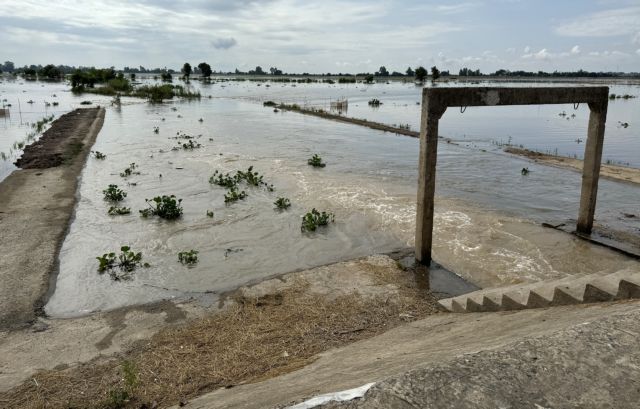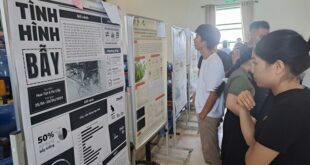 |
| Đồng Tháp Province has opened sluices to let floodwaters enter its rice fields in Hồng Ngự District’s Thường Thới Hậu A Commune as the flooding season begins. – VNA/VNS Photo Nhựt An |
HCM CITY – The Cửu Long (Mekong) Delta is entering its annual flooding season and many rice farmers in upstream provinces have opened their field sluices to let the floodwaters and aquatic creatures in.
The floods are caused by the rising level of the Mekong River during the rainy season, and they bring sediments and fish and other creatures.
The country’s rice granary is expected to have higher levels of floodwaters this year compared to the last two because the forecast is for plenty of rain.
In the upstream provinces of An Giang and Đồng Tháp, where the first floodwaters enter the delta from Cambodia, the floods have started.
Farmers in An Giang’s An Phú District have begun to catch aquatic species in their fields and rivers and canals.
Nguyễn Văn Hiền in the district’s Vĩnh Hội Đông Commune said in recent years flooding had been minimal and late and receded quickly, and so there were few fishes.
In recent days there have been plenty of rains, rivers have been rising rapidly, and he could net lots of fish, he said.
“I catch 5 – 7 kg of fish a day and sell them at a local market, and earn VNĐ200,000 (US$8), and this is enough to cover my family expenses.”
Linh fish (Cirrhinus jullieni) and other speciality flood season products such as điên điển (Sesbania sesban) flowers are sold in many markets in An Giang’s An Phú District.
The flower is used to cook sour and sweet soup and to make fermented pickles.
Phùng Thế Vinh, head of the An Phú District Bureau of Agriculture and Rural Development, said flooding has occurred in Phú Hội, Nhơn Hội and Phú Hữu communes bordering Cambodia.
“This year floodwaters are higher than at the same time last year. We are waiting for farmers to complete harvesting their summer-autumn rice and will work with the three communes to set up a plan to let floodwaters flow into rice fields to wash the alum out.”
In Đồng Tháp Province, after harvesting their summer-autumn rice, farmers in the upstream district of Hồng Ngự District have opened the sluices of their fields to let the floodwaters in.
The floodwaters wash alum out of fields and destroy pathogens.
Hồng Ngự District has designated 13 concentrated farming areas for growing rice and other crops that cover 9,357ha and have embankments to protect them from the floodwaters.
It will open sluices to let the waters into 12 of them over the next two months, according to its People’s Committee.
Dương Văn Thương, a farmer in the district’s Thường Thới Hậu A Commune, said if paddies are not flooded, they require more fertilisers and have weeds and diseases.
According to the Southern Institute of Water Resources Research, storms in the East Sea in late July brought plenty of rains to southern Laos and Cambodia, causing the Mekong to flow higher than in the last several years.
But the flooding reduced to average levels this month.
It is expected to peak in the first half of October.
The flooding has been declining in recent years due to the impacts of climate change and the construction of hydroelectric dams upstream the Mekong River by other countries. – VNS
- Reduce Hair Loss with PURA D’OR Gold Label Shampoo
- Castor Oil Has Made a “Huge” Difference With Hair and Brow Growth
- Excessive hair loss in men: Signs of illness that cannot be subjective
- Dịch Vụ SEO Website ở Los Angeles, CA: đưa trang web doanh nghiệp bạn lên top Google
- Nails Salon Sierra Madre
 VnExpress News The News Gateway of Vietnam
VnExpress News The News Gateway of Vietnam





